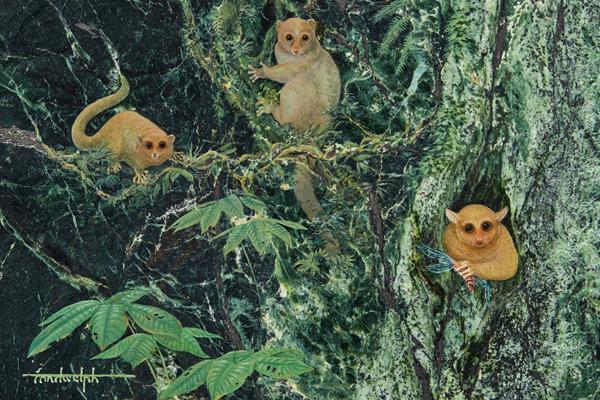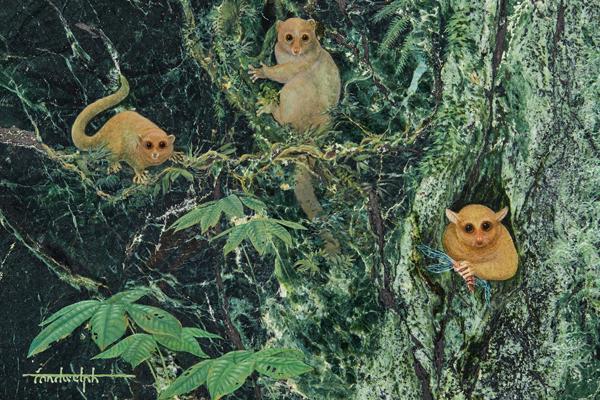
Credit: Painting on marble by Randwulph
AUSTIN, Texas — Biological anthropologists from The University of Texas at Austin have described three new species of fossil primates that were previously unknown to science. All of the new primates were residents of San Diego County at a time when southern California was filled with lush tropical forests.
Since the 1930s, numerous primate fossils have been uncovered in the sandstones and claystones that make up the Friars Formation in San Diego County. Paleontologist Stephen Walsh and fieldworkers from the San Diego Museum of Natural History (SDNHM) built up a large collection of fossil primates from the San Diego area, but Walsh was unable to describe these specimens before his death in 2007.
A decade later, UT Austin graduate student Amy Atwater and anthropology professor Chris Kirk took up the challenge, describing and naming three previously unknown omomyoid primates that lived 42 million to 46 million years ago. The researchers named these new species Ekwiiyemakius walshi, Gunnelltarsius randalli and Brontomomys cerutti.
These findings double the number of known primate genera represented in the Friars Formation and increase the total number of known omomyine primates of that period from 15 to 18.
Atwater and Kirk's descriptions were published in the Journal of Human Evolution.
"The addition of these primates provides for a better understanding of primate richness in the middle Eocene," said Atwater, who is now the paleontology collection manager at the Museum of the Rockies in Bozeman, Montana. "Previous research in the Rocky Mountain basins suggested the primate richness declined during this time period, but we argue that primate richness increased concurrently in other locations."
Studying the teeth, researchers concluded the three new genera, which represent the bulk of the undescribed Friars Formation omomyoid sample at SDNHM, range in size from 113 to 796 grams and are most likely related to a group of extinct species comprising the primate subfamily Omomyinae.
"Teeth can tell us a lot about evolutionary history and give us a good handle on the size and diet of an extinct primate," Kirk said. "Enamel is the hardest tissue in the body. And as a result, teeth are more likely to be preserved in the fossil record."
Ekwiiyemakius walshi, the smallest of the three new species, was estimated to weigh between 113 and 125 grams — comparable in size to some modern bushbabies. It was named for Walsh, who collected and prepared many of the specimens, and also derives from the Native American Kumeyaay tribe's place name, Ekwiiyemak — meaning "behind the clouds" — for the location of the headwaters of the San Diego and Sweetwater Rivers.
Gunnelltarsius randalli was named for Gregg Gunnell, the researchers' late colleague and expert on Eocene mammals, and for SDNHM fossil collections manager Kesler Randall. It was estimated to weigh between 275 and 303 grams, about the size of today's fat-tailed dwarf lemur.
Brontomomys cerutti was large compared with most other omomyoids and was estimated to weigh between 719 and 796 grams — about the size of a living sportive lemur. Due to its large size, its name derives from the Greek word bront?, or "thunder," as well as for Richard Cerutti, the retired SDNHM paleontologist responsible for collecting many of the Brontomomys specimens.
###
Media Contact
Rachel Griess
[email protected]
512-471-2689
@UTAustin
http://www.utexas.edu
Original Source
https://news.utexas.edu/2018/08/28/three-previously-unknown-ancient-primates-identified http://dx.doi.org/10.1016/j.jhevol.2018.04.010





